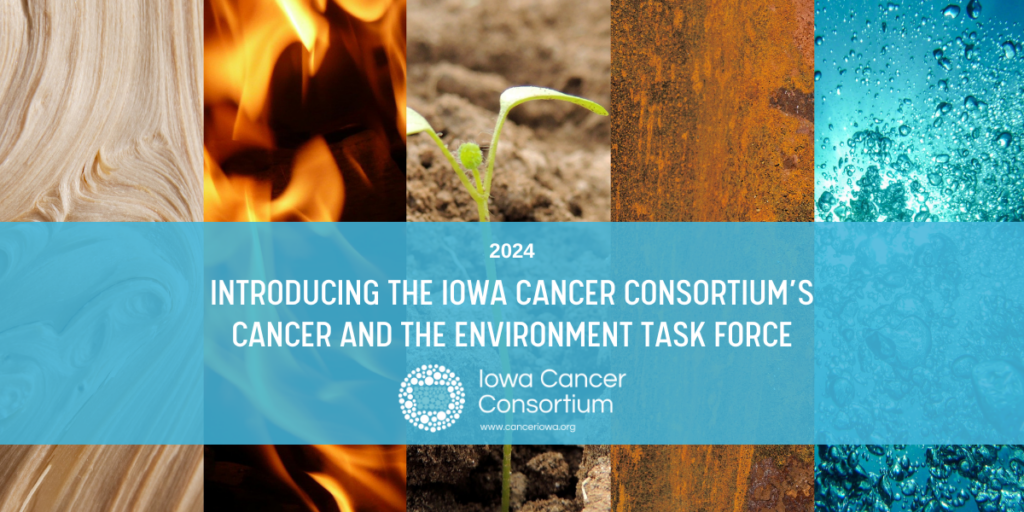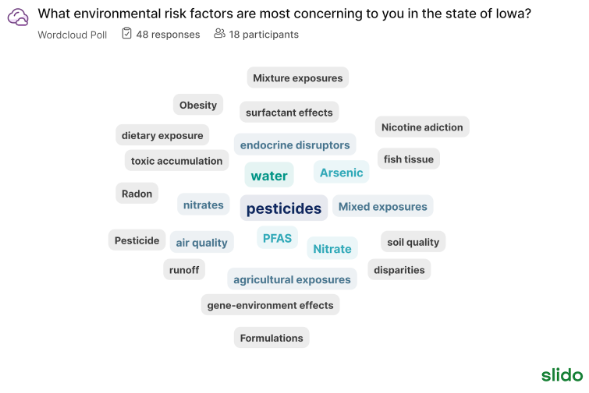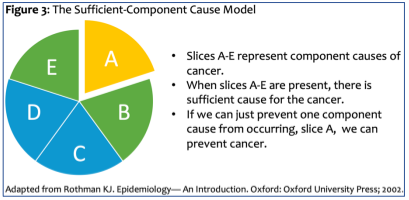Introducing the Iowa Cancer Consortium’s Cancer and the Environment Task Force

The Iowa Cancer Consortium has worked for over 20 years to connect partners who seek to understand the changing landscape of cancer control in Iowa. Recently, Consortium members have come together to create the ‘Cancer and the Environment Task Force’ to examine the relationship between Iowa’s landscape itself and cancer in the state. The growing 48-member task force’s role is to empower partners with resources, knowledge and partnerships to help them succeed in practicing cancer control work through an environmental lens and environmental work through a cancer control lens.
The Iowa Cancer Plan: Reducing Exposures to Environmental Carcinogens
The topic of environmental carcinogens was expanded upon with the most recent revision of the Iowa Cancer Plan. With the aim of preventing cancer from occurring whenever possible, the second chapter of the Iowa Cancer Plan, Prevention and Risk Reduction, includes a priority on reducing exposures to environmental carcinogens. Within this priority are evidence-based strategies and action steps highlighting the need for increased awareness of the connection between environmental carcinogens and cancer risk, as well as the identification of high-priority environmental hazards and preventive actions communities can take to reduce exposure. The Iowa Cancer Plan is meant to provide direction and support for organizations and individuals across the state to collectively reduce the burden of cancer, as it is too big of a problem for one organization to do alone.
Concern over the role of the environment in human health outcomes, including the development of cancer, is not a new or unstudied issue, but the true burden of environmentally induced cancers has been grossly underestimated, according to the President’s Cancer Panel in 2010. Addressing environmental exposures can take on many different paths, as seen by task force responses to this one question:
 From Cancer and the Environment Task Force Meeting, Summer 2023
From Cancer and the Environment Task Force Meeting, Summer 2023
What We’ve Learned
After the task force’s first meeting in the summer of 2023, we recognized that there was a need for both cancer control and environmental health experts to better understand each other’s fields. While both emphasize the importance of upstream interventions in harm prevention and risk reduction, each has something to gain by working with one another to fill knowledge and communication gaps in the state. The Consortium hosted a two-part Cancer and the Environment 101 Webinar Series with Molly Jacobs, MPH, Director of Applied Research for the Sustainable Chemistry Catalyst, a research institute at the Lowell Center for Sustainable Production at the University of Massachusetts Lowell, for part one on environmental exposures and Mary Charlton, PhD, from the University of Iowa and the Iowa Cancer Registry, for part two on cancer trends in Iowa.
One of the key takeaways from this series is a reminder that there is no singular cause of cancer–many factors contribute to whether or not it develops. When we focus on answering the unanswerable, like how much cancer is caused by a certain chemical, or making assumptions about a single cause, we lose sight of finding ways to stop exposures to chemicals we already know cause cancer. Our hope is to avoid getting stuck in outdated or oversimplified paradigms that view cancer as solely a disease of genetics, individual behaviors like smoking or drinking alcohol, or a disease of the aging. The environment a person is in and what they are exposed to impacts their genes (epigenetics), which in turn contributes to their cancer risk. There are different definitions of what makes up someone’s environment, but the Iowa Cancer Consortium views it as anything existing outside of the body – the substances that make up where each of us live, eat, work, and play. Environmental exposures are one piece of the pie that we can take preventive action to keep unfilled and reduce overall cancer risk, as seen in the figure below.
 From Cancer & Environment Network of Southeastern Pennsylvania, Environmental Chemicals and Cancer Science Companion Document, July 2021
From Cancer & Environment Network of Southeastern Pennsylvania, Environmental Chemicals and Cancer Science Companion Document, July 2021
Opportunities for Growth
Bladder cancer survivor and ecologist Sandra Steingraber explains in her book Living Downstream: An Ecologist’s Personal Investigation of Cancer and the Environment that “cancer is an ecological disease with upstream interactions of a complexity that preclude the assignment of a single cause. Cancer is a river whose headwaters is not a single source but a network of streams that both fan out and reconnect”. If we really want to honor the complexity of the river that is cancer, we must collaborate from “river to river” here in Iowa.
The Iowa Cancer Consortium hopes to partner with environmental organizations who are already thinking about upstream solutions to protecting the health and wellness of Iowans. If you’re interested in learning more or joining the Cancer and the Environment Task Force, please email [email protected].
Resources:
- Cancer and the Environment 101 Webinar Series- Part 1: Environmental Exposures and Part 2: Cancer in Iowa
- Iowa Cancer Plan, Chapter 2, Priority 6: Reduce exposure to environmental carcinogens
- Nsedu Witherspoon, Children’s Environmental Health Network (2022 Iowa Cancer Summit Presentation)
- Iowa Environmental Tracking Network
